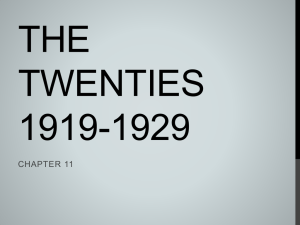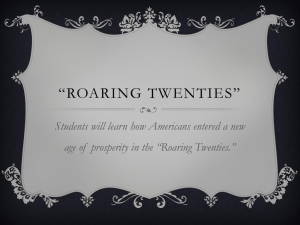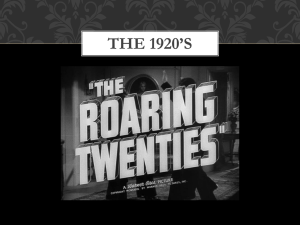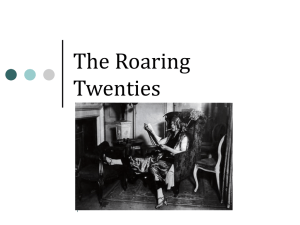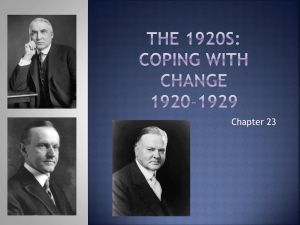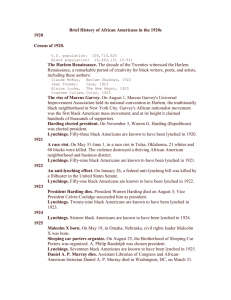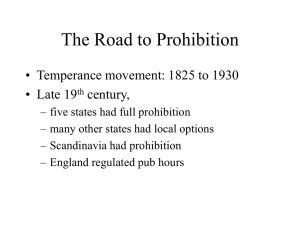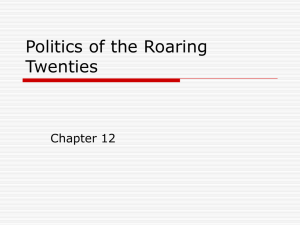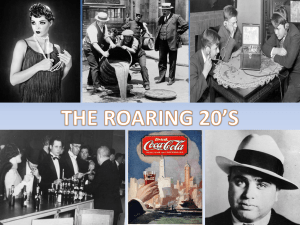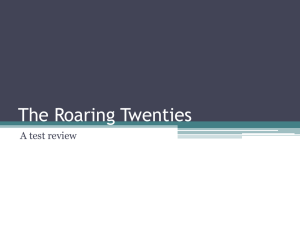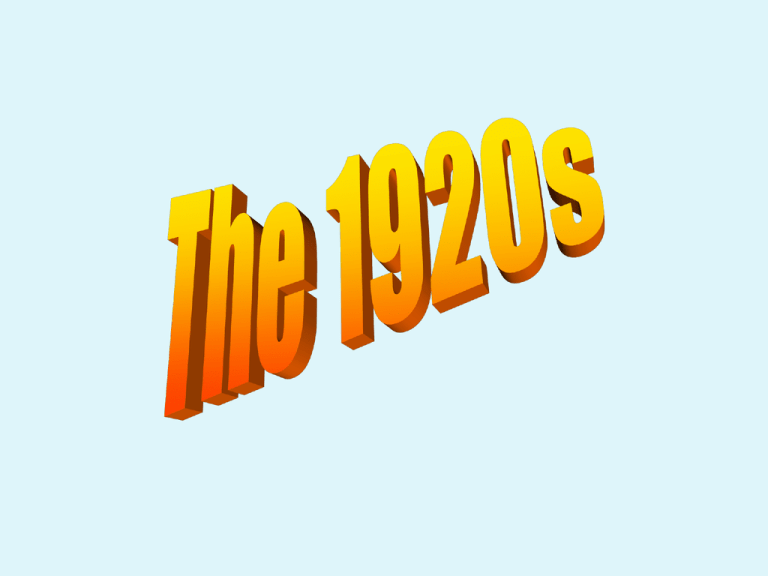
THE WORLD AS IT LOOKED TO
MANY AMERICANS AFTER
WWI, FULL OF PROBLEMS
AND DANGERS.
SOLDIERS
RETURNING TO
THE U.S. AFTER
WWI
M
ilk
,
Sa
lm
M
-1
6
Br
e
rd
,
nd
un
d
un
d
ou
po
po
ca
n
d
un
d
nd
ou
n
oz
ad
,p
La
rin
e,
15
po
ou
,p
of
,
nd
nd
ou
nd
ou
ou
d,
p
,r
ed
ar
ga
ap
,
ev
an
,c
le
g
lic
e
,p
,p
st
be
ef
,s
m
b,
on
La
on
Ba
c
Pl
at
,p
ak
R
oa
St
e
e
in
R
ib
Si
rlo
INFLATION 1913 TO 1925
60
50
40
30
20
10
0
LEGEND
1913
1924
1925
I. Postwar America
A. Americans fearful of outsiders =
nativism – prejudice against foreign
born people.
B. Belief in isolationism (policy of pulling
away from involvement in world affairs)
also divided Americans.
.
C. Fear of Communism – economic
and political system based on a
single-party government ruled by a
dictatorship, in which wealth and
power are equalized, private
property is eliminated and the gov.,
owns all factories, railroads, and
other businesses.
C. Fear of Communism – cont.
1.) Red Scare
• Anti-communist panic began in 1919
after the Russian Revolution called out
for worldwide revolution and the
abolishment of capitalism.
• A Communist party formed in the U.S.
and Americans feared that communism
was spreading to the U.S. - dozens of
bombs were mailed to gov. and
business leaders.
THE RUSSIAN BOLSHEVIK REVOLUTION IN
1917 LED TO WIDE SCALE FEAR IN THE
U.S. THAT COMMUNISTS WOULD TRY TO
TAKE OVER THE COUNTRY
RED SCARE
EVENTS IN RUSSIA AND EUROPE AND MASSIVE STRIKES AT HOME LED TO A FEAR
THAT THE U.S. WOULD BE THE NEXT TARGET OF COMMUNISTS
1.) Red Scare – cont.
- U.S. Attorney General Mitchell Palmer went on
a communist hunt!
- Palmer Raids
- Assisted by J. Edgar Hoover, Palmer
hunted down suspected communists,
anarchists, and socialists.
- they trampled civil rights, invaded homes
and offices and jailed suspects w/out
legal counsel.
- hundreds of foreign-born radicals were
deported w/out trials.
- failed to find evidence of revolutionary
conspiracies!!!
PALMER RAIDS
A. MITCHELL PALMER
AS A RESULT OF THE PALMER
RAIDS HUNDREDS OF
IMMIGRANTS WERE FORCIBLY
DEPORTED TO THEIR HOME
COUNTRIES
“SHIP OR SHOOT”
2.) Sacco and Vanzetti Case
- Nicola Sacco and Bartolomeo Vanzetti, a shoemaker
and a fish peddler, both Italian immigrants and
anarchists; both evaded the draft.
- 1920 arrested and charged with robbery and murder
of two workers.
- witnesses said criminals “looked” Italian
- Sacco and Vanzetti claimed their innocence and
provided alibis, evidence was circumstantial and judge
made prejudicial remarks.
- Jury found them guilty and sentenced them to death!
- protests rang out and many believed they were
mistreated because of their beliefs.
- 1961 ballistics showed that the pistol found on Sacco
was the one used in the murder
SACCO
&
VANZETTI
DESPITE MASSIVE PROTESTS AROUND THE GLOBE SACCO AND VANZETTI
WERE EXECUTED IN AUGUST OF 1927
THE FUNERAL
DEATH MASKS
FEAR OF OUTSIDE INFLUENCES LED TO
RESTRICTIONS ON IMMIGRATION
D. Limiting Immigration – fear of outside
influence led to restrictions on immigration
1.) Emergency Quota Act of 1921 established
a maximum number of people who could
enter the U.S. from each foreign country
- goal was to cut European immigration
- law prohibited Japanese immigration
- quota system did not apply to immigrants
from the Western Hemisphere – during the
1920s about 1 million Canadians and 500,000
Mexicans crossed into the U.S.
2.) Hate groups formed as a result of the Red
Scare and anti-immigrant feelings
- Ku Klux Klan (KKK) was devoted to “100
percent Americanism”
- 4.5 million members by 1924, only
“white male persons, native-born
gentile citizens.”
- targeted African Americans, Roman
Catholics, Jews and foreign-born
people.
EXTREME FEAR OF FOREIGN INFLUENCES
BREEDS HATRED
THE KLAN SHOW ITS POWER AND STRENGTH BY
ORGANIZING A MARCH IN WASHINGTON D.C. IN
1925
50,000 KU KLUX KLAN MEMBERS MARCHING
BY AUGUST OF 1925 THE KLAN HAD 5 MILLION MEMBERS AND CONTROLLED THE SEVERAL
STATE GOVERNMENTS
ANTI SEMITISM IN THE 1920s
ANTI-DEFAMATION LEAGUE FOUNDED,
1913
"THE IMMEDIATE OBJECT OF THE LEAGUE IS TO
STOP, BY APPEALS TO REASON AND CONSCIENCE
AND, IF NECESSARY, BY APPEALS TO LAW, THE
DEFAMATION OF THE JEWISH PEOPLE. ITS ULTIMATE
PURPOSE IS TO SECURE JUSTICE AND FAIR
TREATMENT TO ALL CITIZENS ALIKE AND TO PUT AN
END FOREVER TO UNJUST AND UNFAIR
DISCRIMINATION AGAINST AND RIDICULE OF ANY
SECT OR BODY OF CITIZENS."
ADL CHARTER
OCTOBER 1913
LEO FRANK, JEWISH BUSINESSMAN, WAS
LYNCHED IN ATLANTA IN 1915 FOR A
CRIME HE DID NOT COMMIT
LOGO FROM: www.adl.org
THE NAACP, WHICH WAS FOUNDED IN 1909, REFUSED TO BE
INTIMIDATED BY THE KLAN. THEY HELD THEIR ANNUAL CONFERENCE IN
1920 IN ATLANTA, ONE OF THE MOST ACTIVE KLAN AREAS AT THE TIME.
TWO YEARS LATER, THE NAACP PLACED LARGE ADS IN MAJOR
NEWSPAPERS TO PRESENT THE FACTS ABOUT LYNCHING.
THIS CARTOON SHOWS
THE ANTI-LYNCHING
BILLS BEING PUT OFF BY
CONGRESS. THE NAACP
LOBBIED CONGRESS
UNSUCCESSFULLY FOR
LEGISLATION.
LOGO FROM www.naacp.org
E. Labor Unrest
- During the war strikes were illegal because
they would interfere with the war effort.
- 1919 – there were more than 3,000 strikes
and 4 million workers walked off the job
- Employers did not want to give raises or
allow their workers to join unions.
- Employers labeled striking workers
Communists.
E. Labor Unrest – continued
1.)Boston Police Strike
- grievances =no raise since start of the
war, not allowed to unionize
- representatives asked for a raise and
were fired = strike
- Mass. Governor Calvin Coolidge called
out the Nat’l Guard and ended the strike
- strikers weren’t allowed to return to work
and new police officers were hired.
BOSTON POLICE STRIKE EDITORIAL CARTOONS
E. Labor Unrest – cont.
2.)Steel Mill Strike 1919
- steel workers wanted right to negotiate for
shorter hours and higher wages.
- U.S. Steel Corporation refused to meet with
union reps.
- 300,000 workers walked off the job
- steel companies hired strikebreakers =
employees who agreed to work during the
strike
- striking workers were beaten by police,
federal troops and state militia
- when negotiations deadlocked, Pres. Wilson
issued a plea to the strikers
- Strike ended in 1920
“At a time when the nations of the
world are endeavoring to find a way
of avoiding war, are we to confess
that there is no method to be found
for carrying on industry except … the
very method of war?... Are our
industrial leaders and our industrial
workers to live together without
faith in each other?”
Woodrow Wilson
E. Labor Unrest – cont.
3.)Labor Movement loses appeal in the 1920s
because:
- Most of the work force consisted of
immigrants willing to work in poor
conditions.
- unions had difficulty organizing
- most unions excluded African Americans
1919 CARTOONS ON
THE WAVE OF
STRIKES SWEEPING
THE U.S.
•HARDING 1921-1923
•COOLIDGE 1923-1928
•HOOVER 1929-1933
WARREN HARDING
TWENTY-NINTH PRESIDENT
1921-1923
BORN: NOVEMBER 2, 1865 IN CORSICA, OHIO
DIED: AUGUST 2, 1923 DURING HIS PRESIDENCY WHILE VISITING SAN FRANCISCO,
CALIFORNIA
BEFORE HIS NOMINATION, WARREN G. HARDING DECLARED,
"AMERICA'S PRESENT NEED IS NOT HEROICS, BUT HEALING;
NOT NOSTRUMS, BUT NORMALCY; NOT REVOLUTION, BUT RESTORATION;
NOT AGITATION, BUT ADJUSTMENT; NOT SURGERY, BUT SERENITY;
NOT THE DRAMATIC, BUT THE DISPASSIONATE; NOT EXPERIMENT,
BUT EQUIPOISE; NOT SUBMERGENCE IN INTERNATIONALITY,
BUT SUSTAINMENT IN TRIUMPHANT NATIONALITY...."
Harding speaking
II. Presidential Policies
A. Warren G. Harding
- took office in 1921
- Called for a return to “Normalcy”
1.) Peace/Foreign Policy:
- 1921 – Harding calls a conference in
Washington DC where the U.S. , Great Britain,
France, Japan, and Italy all agree to reduce their
navies.
- 1928 – 15 countries sign the KelloggBriand Pact which renounced war as an
instrument of national policy (pact was futile and
was not enforced)
2.) Tariff and Reparations:
- Conflict arose when Great Britain and France
were asked to pay back the $10 million they
owed the U.S.
- they could do this by, selling goods to the U.S.
or collecting war reparations from Germany
- However, in 1922, the Fordney-McCumber
Tariff was passed raising taxes on imported
goods by 60% - Britain and France could not
afford to sell enough goods to repay the debt.
- GB and France looked to Germany who could
not pay = France marches into Germany
2.) Tariffs and Reparations – cont.
- U.S. wants to avoid war
- American banker Charles G. Dawes is sent to
negotiate loans.
- Dawes Plan = U.S. loans Germany $2.5 billion to
repay Great Britain and France, Great Britain and
France then pay the U.S.
- caused resentment b/c Britain and France
thought the U.S. was stingy for not paying a
fair share of the cost of the war and the U.S.
had benefitted from the defeat of Germany
while Europeans lost millions of lives.
- U.S. considered GB and France financially
irresponsible.
3.) Scandal
- Harding appointed his poker-playing
cronies, known as the Ohio-gang, to important
cabinet positions
- Harding’s administration soon unraveled
b/c his corrupt friends used their offices to
become wealthy through graft.
- Charles Forbes, head of veterans affairs,
illegally sold government and hospital supplies
to private companies.
- Thomas Miller, head of the Office of Alien
Property, caught taking a bribe.
3.) Scandal – cont.
- Teapot Dome Scandal
- gov. had set aside oil-rich land in
Teapot Dome Wyoming, and Elks Hills,
California, for use by the U.S. Navy.
- Sec. of the Interior, Albert B. Fall
managed to get the oil reserves
transferred from the navy to the
Interior Department.
- Fall then secretly leased the land to 2
private oil companies and received
more than $400,000 in “loans, bonds,
and cash.”
- Fall was found guilty of bribery and
became the 1st American to be convicted of a
felony while holding a cabinet position.
HARDING’S ADMINISTRATION WAS ROCKED BY SCANDALS. HE SAID, OF THE FRIENDS HE
HAD APPOINTED TO HIGH OFFICE,
"MY GOD, THIS IS A HELL OF A JOB! I HAVE NO TROUBLE WITH MY ENEMIES . . . BUT MY
DAMNED FRIENDS... THEY’RE THE ONES THAT KEEP ME WALKING THE FLOOR NIGHTS."
THREE MAJOR SCANDALS:
1. IN THE VETERANS' BUREAU 2. IN THE OFFICE OF THE ALIEN PROPERTY CUSTODIAN 3. IN
THE DEPARTMENTS OF THE INTERIOR AND JUSTICE.
4.) Harding’s Death
- August 2, 1923 Harding dies suddenly
- Vice President Calvin Coolidge takes
office just as the scandals from Harding’s
administration come to light.
B. Calvin Coolidge’s Presidency
1.) Assumes office in 1923 upon Harding’s death
2.) Won the election of 1924
3.) Goals:
- keep taxes down, business profits up, keep
government interference in business to a
minimum and allow private enterprise to
flourish.
4.) Coolidge’s admin. placed high tariffs on
foreign imports, which helped American
manufacturers.
5.) Wages rose!!
PRESIDENT COOLIDGE: 1923-1929
“THE BUSINESS OF AMERICA IS BUSINESS"
"CIVILIZATION AND
PROFITS GO HAND IN
HAND"
COOLIDGE WAS THE LEAST ACTIVE PRESIDENT IN HISTORY, TAKING DAILY AFTERNOON NAPS
AND PROPOSING NO NEW LEGISLATION
ELECTION OF 1928
III. Life in the 1920s
A. The Automobile changed the American landscape
1.) Led to the construction of paved roads
2.) Construction of Route 66 led to settlement
out west
3.) Architectural styles of homes changed b/c
people needed garages = smaller lawns
4.) Construction of gas stations, repair shops,
motels, tourist camps, shopping centers
5.) First automatic traffic signals, underwater
tunnels for vehicles
6.) connected rural families to the cities
7.) allowed families to vacation in new, faraway
places
8.) allowed workers to live miles from their
jobs = urban sprawl – cities spread in all
directions.
9.) auto industry provided an economic base
for many cities like Akron, Ohio and Flint,
Michigan
10.) auto industry symbolized the success of
the free enterprise system
11.) planned obsolescence – manufacturing
concept which calls for slight changes in style to be
made periodically in order to encourage customers to
discard old models and buy newer ones.
(By the late 1920s, 80% of all registered vehicles in the
world were in the U.S.)
THE AUTOMOBILE, ELECTRICITY AND HOUSING INDUSTRIES
WERE THE MAJOR FACTORS FUELING THE ECONOMIC
“BOOM” OF THE 1920s
HENRY FORD, THE MAN WHO REVOLUTIONIZED MANUFACTURING
BY MECHANIZING THE ASSEMBLY LINE MODE OF PRODUCTION
IN 1925 FORD WAS PRODUCING NEW MODEL T’S AT
THE RATE OF ONE EVERY TEN SECONDS.
$265 =$2742 IN 2002 DOLLARS
$685.00 =$7089.00 IN 2002
DOLLARS
$775.00 =$7863.00 ON 2002
DOLLARS
INADEQUATE PARKING AND ROADS WERE APPARENT BY
THE MID 1920s
B. Airplane Industry
- Transatlantic flights by Charles Lindbergh
and Amelia Earhart helped promote cargo
and commercial airlines.
- 1927 the Lockheed Company produced a
single-engine plane called the Vega which
became the most popular transport airplanes
in the 1920s.
- 1927 – Pan American Airlines was founded
and inaugurated the first transatlantic
passenger flights
LINDBERGH FLIES ACROSS THE ATLANTIC SOLO
C. Standard of Living Soars
- 1920-1929 – Americans owned 40% of the
world’s wealth
- average annual income rose more than 35% from $522-$705 – people were eager to spend
their extra money
1.) Electricity spread from cities to suburbs
and created new electric appliances
2.) Modern advertising emerged as
companies hired psychologists to study
how to appeal to people.
ADVERTISING BECAME THE VEHICLE TO SELL MASS
CULTURE
1930’S HOME FURNISHINGS
WITH INSTALLMENT (CREDIT) PRICES
D. A Superficial Prosperity
- growing gap between rich and poor
- farmers suffered because of overproduction
during WWI.
- installment plans (credit) – allowed people
to buy goods over an extended period w/out
putting much money down at the time of
purchase.
- most Americans focused on the present and
didn’t believe anything could go wrong with
the economy!
E. Prohibition
1.) January 1920 the 18th Amendment went into effect
prohibiting the manufacture, sale, and transportation
of alcoholic beverages.
2.) Volstead Act established the Prohibition Bureau in
the Treasury Department.
- agency was underfunded and the job of
patrolling the sale and distribution of alcohol
nationwide was left up to a few individuals.
3.) To obtain liquor illegally, people went to hidden
saloons and nightclubs called speakeasies because
when inside you one spoke quietly or “easily” to avoid
detection.
4.) People also bought liquor from bootleggers (named
for the practice of carrying liquor strapped to your
boots) who smuggled liquor from other countries.
CARRY NATION, A LEADING
ACTIVIST OF THE ANTITEMPERANCE MOVEMENT
THE 18TH AMENDMENT, 1919, MADE PROHIBITION THE LAW OF
THE LAND
AMENDMENT XVIII
SECTION 1. AFTER ONE YEAR FROM THE RATIFICATION OF THIS ARTICLE THE
MANUFACTURE, SALE, OR TRANSPORTATION OF INTOXICATING LIQUORS WITHIN,
THE IMPORTATION THEREOF INTO, OR THE EXPORTATION THEREOF FROM THE
UNITED STATES AND ALL TERRITORY SUBJECT TO THE JURISDICTION THEREOF FOR
BEVERAGE PURPOSES IS HEREBY PROHIBITED.
SECTION 2. THE CONGRESS AND THE SEVERAL STATES SHALL HAVE CONCURRENT
POWER TO ENFORCE THIS ARTICLE BY APPROPRIATE LEGISLATION.
SECTION 3. THIS ARTICLE SHALL BE INOPERATIVE UNLESS IT SHALL HAVE BEEN
RATIFIED AS AN AMENDMENT TO THE CONSTITUTION BY THE LEGISLATURES OF THE
SEVERAL STATES, AS PROVIDED IN THE CONSTITUTION, WITHIN SEVEN YEARS FROM
THE DATE OF THE SUBMISSION HEREOF TO THE STATES BY THE CONGRESS.
THE 18TH AMENDMENT WAS
ENFORCED BY THE VOLSTEAD
ACT
CONGRESSMAN ANDREW VOLSTEAD
THE VOLSTEAD ACT IN ACTION
click
A MAJOR EFFECT OF PROHIBITION WAS THE RISE OF CRIMINAL
ORGANIZATIONS FORMED TO SATISFY THE DEMANDS OF
AMERICANS WHO DECIDED THEY WANTED LIQUOR IN SPITE OF THE
18TH AMENDMENT AND VOLSTEAD ACT.
5.) Prohibition contributed to organized crime
in every major city
6.) Al Capone – famous gangster whose
bootlegging empire brought in $60 million
a year
- Capone killed off his competition and
1920s headlines reported 522 bloody
gang killings
7.) By mid- 1920s only 19% of Americans
supported prohibition b/c many thought it
caused more problems
8.) 1933 – 21st Amendment repealed prohibition
AL CAPONE A.K.A SCARFACE
DEATHS DUE TO ALCOHOL, COOK COUNTY, ILLINOIS 1910-1926
SOURCE: US SENATE JUDICIARY COMMITTEE HEARINGS ON NATIONAL PROHIBITION, 1926
F. Science
1.) Scopes Trial
- March 1925 – Tennessee passed the nation’s
first law making it a crime to teach evolution
- the ACLU promised to defend any teacher
who would challenge the law.
- John T. Scopes, a biology teacher in Dayton,
Tenn., was arrested for reading a passage
about evolution
- Famous trial attorney, Clarence Darrow, was
hired by the ACLU to take the case.
- trial opened July 1925 and instantly became a
national sensation!
- Scopes was found guilty, fined $100, verdict later
overturned on a technicality but the Tennessee
law remained in effect.
SCOPES TRIAL
THE ACLU RAN AN AD IN THE LOCAL DAYTON, TENNESSEE PAPER LOOKING FOR A TEACHER
WHO WOULD HELP TO CHALLENGE THE CONSTITUTIONALITY OF THE NEW LAW
FORBIDDING THE TEACHING OF EVOLUTION IN PUBLIC SCHOOLS.
JOHN SCOPES,
THE TEACHER
WILLIAM JENNINGS BRYAN, THE PROSECUTOR
CLARENCE DARROW, THE DEFENSE
LAWYER
THE JULY 1925 TRIAL QUICKLY TURNED INTO A MEDIA CIRCUS
WITH BANNERS DECORATING THE STREETS. FOOD AND DRINK
STANDS WERE SET UP. RUMORS WERE THAT CHIMPANZEES HAD
BEEN BROUGHT TO TOWN TO TESTIFY FOR THE PROSECUTION.
THE PRESS DESCENDED ON DAYTON WITH EDITORIAL
CARTOONISTS AND HAD A FIELD DAY RIDICULING THE TRIAL.
THE TRIAL ENDED WITH A CONFRONTATION BETWEEN BRYAN ON THE WITNESS STAND AND DARROW
QUESTIONING HIM ABOUT CREATION THEORY. BRYAN WAS UNABLE TO CONVINCINGLY DEFEND HIS
POSITION, ALTHOUGH BECAUSE THE JUDGE DID NOT ALLOW ANY DISCUSSION ABOUT THE VALIDITY OF
EVOLUTIONARY THEORY SCOPES WAS FOUND GUILTY AND FINED $100.00. LATER THE CONVICTION WAS
THROWN OUT IN THE APPEAL. HOWEVER THE LAW WAS NOT REPEALED UNTIL 1967.
G. Women in the 1920s
1.) Flappers – emancipated women who
embraced the new fashions and urban
attitudes of the time
- New, revealing clothes
- short hair cuts, dyed black
- more women began smoking cigarettes,
drinking in public and talking openly
about sex
- marriage was seen more as a partnership
between men and women – although
housework and child-rearing still seen as
a woman’s role
WOMEN AT TURN OF THE
CENTURY
WOMEN IN THE 1920s
FLAPPERS
POPULAR MAGAZINE COVERS
WOMEN BEING ARRESTED IN 1922 FOR WEARING
REVEALING BATHING SUITS
THE NEW WOMAN OF THE 1920s
1872
1926
2.) Double Standard
- although newspapers, magazines,
advertisements, etc. promoted the
flapper, many other young women were
against the new image of women.
- casual dating became increasingly
accepted but more sexual freedom was
granted to men than women.
3.) New work opportunities
- many female college graduates turned to
“female professions” like teachers, nurses,
librarians, receptionists, typists, secretaries
NEW CAREERS AND
OPPORTUNITIES OPENED UP
FOR WOMEN IN THE 1920s
4.) Changing Role of the Family
- Birthrate continued to decline b/c of
availability of birth control.
- social and technological advancements
simplified the household.
- children no longer worked = school
5.) Education and Popular Culture
- School enrollment increased
- growing mass media
- radio widely used
- first major movies w/ sound, first animated
films w/sound
THE JAZZ SINGER WAS THE FIRST SUCCESSFUL TALKING PICTURE
IV. The Harlem Renaissance
1.) Move North
- 1910-1920 = Great Migration – movement of
thousands of African Americans North
- northern cities did not always welcome
this influx = 25 urban race riots in 1919 alone
2.) African-American Goals
- National Association for the Advancement of
Colored People (NAACP) urged African
Americans to protest racial violence and called
for legislation to curb racial violence.
3.) Marcus Garvey and the UNIA
- many African Americans chose to follow
Marcus Garvey, a Jamaican immigrant who
believed that African Americans should form
their own separate society.
- 1914 Garvey founded the Universal Negro
Improvement Association (UNIA)
- Garvey encouraged followers to return to
Africa, kick out the white colonial leaders, and
establish a mighty nation.
- Garvey lost followers in the mid-1920s when
he was charged with mail fraud and jailed.
MARCUS GARVEY
4.) Harlem Renaissance
- many African-Americans who migrated north
moved to Harlem in Manhattan = Harlem
became the largest black urban community
- Harlem suffered poverty, overcrowding and
unemployment but in the 1920s these
problems were masked by the creativity of the
Harlem Renaissance – a literary and artistic
movement celebrating African- American
culture.
HARLEM RENAISSANCE: 1919 TO 1935, HARLEM NEW YORK CITY
AFTER WWI MANY BLACKS FLED THE
SOUTH FOR BETTER ECONOMIC
OPPORTUNITIES AND FREEDOM FROM
KKK VIOLENCE. HARLEM, NEW YORK
WAS A POPULAR DESTINATION AND
NEW YORK CITY’S BLACK POPULATION
SWELLED FROM 30,000 IN 1900 TO
OVER 300,000 IN 1930.
BLACK ARTISTS, WRITERS, DANCERS, POETS, HISTORIANS, AND
MANY OTHERS TURNED HARLEM INTO A CENTER OF CULTURE,
CREATIVITY, AND EXPLORATION OF AFRICAN AMERICAN ROOTS.
- Harlem Renaissance – continued
- Writers expressed a new pride in the AfricanAmerican experience, celebrated their heritage and
wrote about what it meant to be black in American
society.
- Claude McKay - novelist and poet urged African
Americans to resist prejudice and wrote about the pain
of life in the black ghettos
- Langston Hughes – poet who’s best known works
described the difficult lives of working-class African
Americans. Some of his poems moved to the tempo of
jazz and blues.
- Zora Neale Hurston – famous for her short stories,
novels and books about poor unschooled Southern
blacks.
LANGSTON HUGHES
ZORA NEALE HURSTON
- African Americans and Jazz
- Jazz was born in New Orleans in the early
20th Century
- Louis Armstrong – outstanding trumpet
player famous for his sense of rhythm and
ability to improvise.
- Edward Kennedy “Duke” Ellington – jazz
pianist, led a ten-piece orchestra at the
famous Cotton Club in Harlem
- Bessie Smith – famous blues singer who
became the highest paid black artist in
the world
JAZZ WAS SO POPULAR THAT THE 20s IS OFTEN REFERRED
TO AS THE JAZZ AGE
DUKE ELLINGTON
BIG BAND
LOUIS ARMSTRONG

